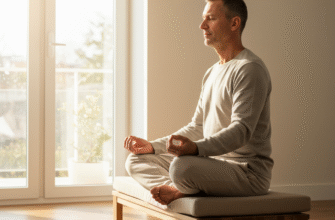We rush through our days, ticking off tasks, chasing deadlines, and planning for the future. Amidst this constant motion, how often do we pause to appreciate the intricate, tireless work happening within our own bodies? It’s easy, almost automatic, to take the fundamentals for granted – the steady beat of our heart, the effortless exchange of air in our lungs, the simple miracle of sight or the ability to move our limbs. These aren’t just background processes; they are the very foundation of our existence, the silent engines powering every single moment.
Cultivating gratitude for these basic bodily functions isn’t about adopting some mystical practice, though it can feel profound. It’s about shifting perspective. It’s about recognizing the incredible biological machinery we inhabit and acknowledging its constant, often unnoticed, service. Think about it: your digestive system is breaking down food, extracting nutrients, and discarding waste, all without conscious instruction. Your immune system is constantly patrolling, identifying and neutralizing potential threats. Your nerves are transmitting signals at incredible speeds, allowing you to feel, think, and react. This happens every second, without fail, until something goes wrong.
The Overlooked Symphony Within
We tend only to notice these functions when they falter. A blocked nose suddenly makes breathing a conscious, frustrating effort. A stomach bug turns the usually seamless process of digestion into a painful ordeal. A sprained ankle transforms walking, previously an afterthought, into a challenging task. It’s often in these moments of disruption that we gain a fleeting appreciation for what we usually possess without a second thought. But why wait for illness or injury to feel thankful?
Developing a consistent practice of gratitude for our bodies, even in their mundane operations, can be surprisingly grounding. It anchors us in the present moment, reminding us of the physical reality of being alive. In a world saturated with digital distractions and abstract worries, reconnecting with the tangible workings of our own physiology can be a powerful antidote to stress and anxiety. It’s a way of saying ‘thank you’ to the vessel that carries us through life.
Simple Acts of Bodily Appreciation
So, how can we actively cultivate this sense of gratitude? It doesn’t require grand gestures. It starts with small moments of mindful awareness.
- Mindful Breathing: Take a few moments several times a day simply to notice your breath. Feel the air entering your nostrils, filling your lungs, and then being released. Don’t try to change it; just observe the steady, life-sustaining rhythm. Acknowledge the work your lungs and diaphragm are doing.
- Sensory Awareness: Pause and tune into your senses. What can you see right now? Appreciate the colours, shapes, and light. What can you hear? Notice the sounds near and far. What can you feel? The chair beneath you, the texture of your clothes, the temperature of the air. Thank your eyes, ears, and skin for providing this constant stream of information.
- Movement Meditation: As you walk, stretch, or even just wiggle your fingers, bring your attention to the sensation of movement. Appreciate the coordination of muscles, bones, and nerves that allows for this action. Be thankful for the simple ability to move your body through space.
- Mealtime Gratitude: Before eating, take a second to acknowledge the process of digestion that’s about to begin. Thank your body for its ability to take in food, break it down, and use it for energy and repair. Appreciate the sense of taste and smell.
- Heartbeat Check-in: Gently place a hand over your heart. Feel its steady beat. Recognize this constant rhythm as a symbol of life, pumping blood and oxygen throughout your entire body, tirelessly, day and night. Offer a silent thanks.
Beyond the Physical: Mental and Emotional Benefits
This practice isn’t just about appreciating the physical mechanics; it has ripple effects on our mental and emotional well-being. Focusing on what our bodies can do, rather than dwelling on perceived imperfections or limitations, fosters a more positive body image. It shifts the focus from external appearance to internal function and capability. This can be incredibly empowering.
Furthermore, gratitude is consistently linked to increased happiness and reduced stress. When we regularly acknowledge the good, even the seemingly small good like the ability to breathe easily, it retrains our brains to look for the positive. It provides perspective, making daily annoyances seem less significant in the grand scheme of simply being alive and functional.
Integrating Gratitude into Daily Life
Making this a habit requires conscious effort initially, but it becomes more natural over time. Consider these integration strategies:
- Morning Moments: Before getting out of bed, take 60 seconds to scan your body and feel gratitude for the rest it received and its readiness for the day. Thank your eyes for opening, your lungs for breathing, your limbs for their potential to move.
- Transition Times: Use moments like waiting in line, commuting, or washing your hands as cues to check in with your body and offer a quick thanks for a specific function – your steady hands, your ability to stand, your sense of touch.
- Gratitude Journaling: Dedicate a small section of a journal to noting down bodily functions you are grateful for each day. It might be as simple as “Grateful for my strong legs that carried me today” or “Thankful for my digestion working smoothly.”
This isn’t about ignoring challenges or pretending pain doesn’t exist if you experience chronic illness or disability. Instead, it can be about focusing on what is working, no matter how small it may seem. It’s about finding appreciation for the parts of the body that are still supporting you, the breath that still flows, the senses that still function, even amidst difficulty. It’s a subtle but powerful shift from focusing solely on what’s wrong to acknowledging what’s right.
Remember that bodily functions can change unexpectedly due to illness or injury. Cultivating gratitude now helps build resilience and perspective for times when things might not work as seamlessly. Never take the intricate workings of your body for granted; appreciate them while they serve you well. This appreciation fosters a deeper connection to your own life force.
A Foundation for Well-being
Ultimately, appreciating our basic bodily functions is a fundamental form of self-care. It costs nothing, takes only moments, and requires no special equipment. It’s accessible to everyone, everywhere. By tuning into the quiet miracles happening within us every second, we build a stronger connection to ourselves, foster a more positive outlook, and lay a foundation of gratitude that can enhance our overall sense of well-being. Start today. Take a deep breath. Feel your heart beat. And simply say, thank you.








